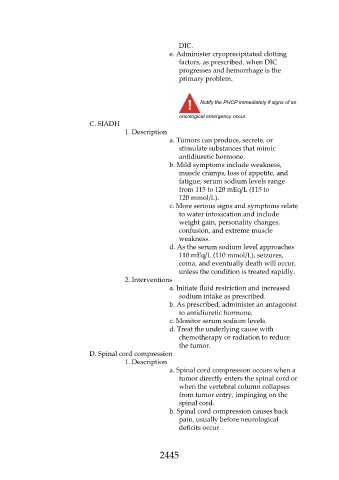Page 2445 - Saunders Comprehensive Review For NCLEX-RN
P. 2445
DIC.
e. Administer cryoprecipitated clotting
factors, as prescribed, when DIC
progresses and hemorrhage is the
primary problem.
Notify the PHCP immediately if signs of an
oncological emergency occur.
C. SIADH
1. Description
a. Tumors can produce, secrete, or
stimulate substances that mimic
antidiuretic hormone.
b. Mild symptoms include weakness,
muscle cramps, loss of appetite, and
fatigue; serum sodium levels range
from 115 to 120 mEq/L (115 to
120 mmol/L).
c. More serious signs and symptoms relate
to water intoxication and include
weight gain, personality changes,
confusion, and extreme muscle
weakness.
d. As the serum sodium level approaches
110 mEq/L (110 mmol/L), seizures,
coma, and eventually death will occur,
unless the condition is treated rapidly.
2. Interventions
a. Initiate fluid restriction and increased
sodium intake as prescribed.
b. As prescribed, administer an antagonist
to antidiuretic hormone.
c. Monitor serum sodium levels.
d. Treat the underlying cause with
chemotherapy or radiation to reduce
the tumor.
D. Spinal cord compression
1. Description
a. Spinal cord compression occurs when a
tumor directly enters the spinal cord or
when the vertebral column collapses
from tumor entry, impinging on the
spinal cord.
b. Spinal cord compression causes back
pain, usually before neurological
deficits occur.
2445

